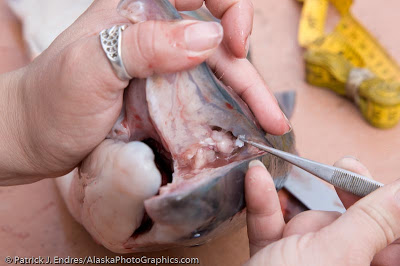 Erin Nicholsan with the Alaska Department of Fish and Game removes the earbone from a Sockeye salmon caught in the Copper River. The earbones are marked when the fish are fry at the Gulkana hatchery, and can be identified as adults.
Erin Nicholsan with the Alaska Department of Fish and Game removes the earbone from a Sockeye salmon caught in the Copper River. The earbones are marked when the fish are fry at the Gulkana hatchery, and can be identified as adults.
This post is part of the photo essay I’m working on about the hatchery enhanced Sockeye salmon of the Copper river.
There is an extensive story to be told of the difficulties in raising Sockeye salmon in a hatchery environment. This is in part due the Sockeye’s susceptibility to a virus which can spread quickly and deliver extensive mortality. The Gulkana hatchery has taken measures to deal with this issue, and have had amazing success. In order to judge long term survivorship of hatchery fish, they need to be marked in some fashion. This used to be done with a variety of tags placed on a small percentage of fish. More recently however, a new type of marking is done at hatcheries which effects the earbone of each fish, thereby marking 100% of the fish, and in a sense, branding them. The Gulkana hatchery uses a salt based water solution to mark their fish, which enables the fish that are caught throughout the commercial and personal use fisheries to be identified. In order to do this, the earbone is removed from the fish, dried out, then looked at under an electron microscope (more on that in another post). After I returned from the river with my Salmon, an ADF&G technician removed the earbones from all my fish and sent them off for testing. The percentage of Gulkana hatchery red salmon caught annually varies, and in a later post, I’ll address some of those numbers.






